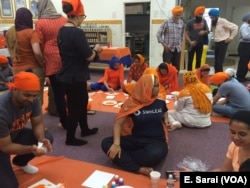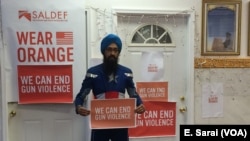A few hundred meters from Washington's National Cathedral, one of the country's largest Christian churches, Sikhs gathered at the city’s gurdwara — a Sikh place of worship — Saturday for an afternoon of workshops, music and art to honor victims of gun violence.
“The Sikh community is no stranger to gun violence,” Amrita Bamrah of the Sikh American Legal Defense Fund (SALDEF) said in her opening statement at the event.
SALDEF organized the event in solidarity with “Wear Orange” — a campaign started by friends of a Chicago victim of gun violence who chose to wear orange, symbolizing the color hunters wear to protect themselves in the woods.
The Washington Sikh community's “SALDEF Wears Orange” observance, followed National Gun Violence Awareness Day, marked nationwide on Friday.
Sikhs increasingly targeted
Devout male Sikhs are required to keep their hair long and wear turbans as a commitment to their faith. Followers of the Sikh faith, a monotheistic religion that originated in northern India, are often confused with Muslims, and have increasingly been the victims of hate crimes over the past year, according to reports by Georgetown University's Bridge Initiative and the Southern Poverty Law Center.
In March, a Sikh-American in Washington state was shot in the arm in his own driveway and told to “go back to your own country.”
The most deadly attack on Sikhs in the U.S. occurred on August 5, 2012, at a gurdwara in Oak Creek, Wisconsin. Six Sikhs were fatally shot by a white supremacist who shot himself to death as police closed in.
At Saturday's event in Washington, there was scarcely any talk about policy or American gun laws. "We're just creating a space to honor lives — a kind of vigil through art and performances," Bamrah told VOA. "It's not at all focused on policy."
Mixed views on gun policy
Though members of the Sikh-American community, like many others, are divided in their opinions about laws limiting private ownership of firearms, those who took part in the Washington Gurdwara's event could at least agree that they would work together to combat gun violence and to increase awareness of the issues within the Sikh community.
“I was a gun owner at the age of 18 and I still am,” Kamal Saini, the son of one of the victims of the Oak Creek shooting, told attendees.
Saini, a member of the U.S. Marine Corps, which he called “arguably the biggest gun club in the U.S.,” said he decided to enlist to honor his mother.
“My mom was very patriotic. ... She loved the American dream — running a business, driving American muscle. She loved this country, she really did.”
But he worries that an unwillingness to talk about guns in the Sikh community, even after Oak Creek and other tragedies, will only lead to more Sikhs being killed.
“The important thing is to go out and go to events like this — where it’s non-political-friendly, where I can actually speak from the heart,” he told VOA.
Before Saini’s speech, Vishavjit Singh, an activist known as “Sikh Captain America,” conducted a workshop asking attendees to guess how many Americans die every day as a result of gun violence (93, according to government data). Then he asked everyone to estimate how many of those killed by guns were victims of homicide (34 percent), suicide (62 percent) or terrorism (a minuscule amount).
Like Saini, Singh also believes that regardless of political leanings, the Sikh community needs to pay more attention to gun violence in America.
“There are three reasons why South Asians should be worried about gun violence,” Singh told the attendees, as he listed criminal incidents, Sikh-on-Sikh crimes and hate crimes.
Over the past year, at least two Sikh men were shot and killed in New Jersey and South Carolina in armed robberies at gas stations. Neither incident was found to be motivated by racial or religious discrimination.
“This problem impacts us and we’re going to have to be part of the solution ourselves,” he said.
Following the speeches and a musical performance with a classical Indian interlude, attendees were invited to express their feelings through painting and posing for pictures. And, as is common at any Sikh gathering, the event concluded as it began three hours earlier — with plenty of food.









